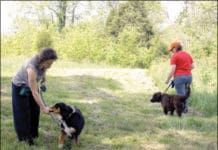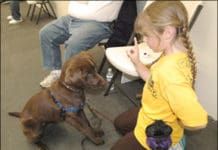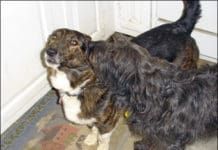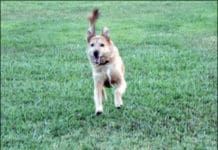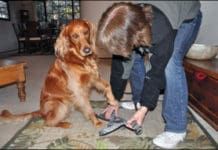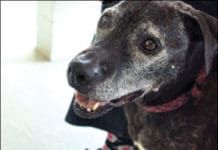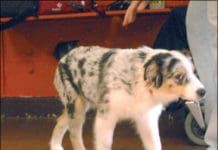Home Search
allergies/feed/rss2/Rawhide%20chews%20are%20potentially%20dangerous%20because%20they%20can%20be%20a%20choking%20hazard%20or%20cause%20gastrointestinal%20obstructions%20if%20your%20dog%20manages%20to%20chew%20off%20a%20piece%20that%20is%20small%20enough%20to%20swallow,%20but%20too%20large%20to%20pass%20unimpeded.%20In%20addition,%20some%20rawhide%20chews%20are%20hard%20enough%20to%20break%20or%20damage%20teeth. - search results
If you're not happy with the results, please do another search
The Benefits of Crate Training Your Dog From an Early Age
I am a huge fan of crate training for dogs. I think the ability to spend an extended amount of time in an enclosed space quietly and calmly is a valuable life skill for dogs. And it certainly has dozens of benefits for us, too. A crate and crate-trained dog ensure that you and your dog will be welcome at most friends' and relatives' homes. I recently stayed at a friendS' house over the holidays, with my foster dog! She doesn't have enough training or self-control to abstain from chasing a strange cat, eating the cat's food, chewing on the furniture, or stealing food off the table, but none of these things happened, because she was happy to spend all of her unsupervised time in their home in her crate.
Help for Dogs With a Healthy Phobia of Stairs
Occasionally I’ll get a call from a client who is having trouble getting their dog to go up or down stairs – a frustrating dilemma when you want your canine companion to be able to accompany you wherever you go. First, be sure your stairs are covered with a traction-providing surface, so he doesn’t slip and scare himself if he tries to use them. Next, here are some tips for overcoming this challenge.
Understanding Aggression in Dogs
Aggression. It's a natural, normal dog behavior, but it's also a scary word that evokes images of maulings and dog-related fatalities. The term aggression" actually encompasses a long continuum of behaviors
Getting the Most Out of Puppy Kindergarten
You've got a new puppy and are about to start puppy classes (or are planning ahead for your new pup even better!). You know good puppy classes are an integral part of helping you and your dog invest in a long and harmonious future. Puppy classes aren't magic. Just signing up, paying, and attending aren't enough. You have to train and practice and build your relationship with your puppy. It will last a lifetime and the effort you put in now will pay off multifold. But keep in mind that the bad habits that you and your puppy develop now will also give you payback many times over! So let's assume you have really committed yourself to rearing a puppy well, and talk about how to get the most out of your puppy classes
Obsessive Compulsive Behavior in Dogs
Owners of herding and sporting breeds Border Collies, Aussies, Kelpies, Labradors, Goldens, and others often cheerfully talk about their dogs' obsession" with tennis balls. What they really mean is that their dogs are very reinforced by the opportunity to chase a ball. That kind of intense interest in a ball or toy can be useful for training and management purposes
Reinforcing Your Dog’s Training Throughout His Lifetime
When I was a kid, nobody talked about “socializing” their dogs, and most of the dogs we knew were just fine with kids. What’s the big deal? At risk of sounding old, when I was a kid, it was a different world. The only dogs I knew who weren’t free to run around my rural neighborhood were either hunting dogs or watchdogs; kids knew not to fool around with any of those dogs. And all the ones running loose in the neighborhood were extremely “good with kids.” That’s because they were constantly exposed to kids! I want my dog to be as rock-solid with kids – and every other type of person – as he is at resisting the urge to chase cats. So we’re going to have to practice.
My Dog Wakes Up Too Early!
Those last few minutes of sleep before the alarm goes off are a treasured sanctuary where we hide in dreams before the reality of the world intrudes. Few dog owners appreciate their canine pals robbing them of those golden moments. But some dogs seem to have an uncanny knack for anticipating the alarm by 15 or 20 minutes, and manage to routinely do just that. Of course, puppy owners expect to be awakened by their baby dogs or they should. It's unreasonable to think a young puppy can make it through the night without a potty break.
Walking An Excited Dog
You contemplate taking your dog for a walk with mixed emotions. You love the idea of going for a companionable stroll through the neighborhood together, but it's a major hassle to get out the door. When you pick up his leash he becomes the Tasmanian Devil body slamming you, racing around the foyer, and bouncing off the plate glass door with such intensity you're afraid he'll crash right through it.
Caring for an Elderly Dog
Aaron Epstein's 14-year-old Australian Shepherd-mix, Sam, was losing weight and his appetite wasn't the same. I just thought he was getting old because in addition to not eating with the same vigor
Problems With Adopting Two Puppies Simultaneously
There's no denying it: a new puppy is one of the world's most wonderful things. It's a cold, hard heart that doesn't get all mushy over puppy breath, soft pink puppy pads, and the fun of helping a baby dog discover his new world. So, if one puppy is wonderful, two puppies must be twice as wonderful, right? Well, not usually. Most training professionals strongly recommend against adopting two pups at the same time. The biggest challenge of adopting puppy pairs is their tendency to bond very closely with each other, often to the exclusion of a meaningful relationship with their humans. They can become inseparable. Also, owners often underestimate the time commitment required to properly care for and train two puppies; as a result the pups often end up untrained and undersocialized.
Dog Growling: 5 Steps to Help Your Dog
Growling is a valuable means of communication for a dog something that dog owners should appreciate and respect rather than punish. Of course, we don't want our dog to growl at us, but neither do we want him to fail to growl if something makes him uncomfortable; that's very important information in a successful canine-human relationship. It's very common for dog owners to punish their dogs for growling. Unfortunately, this often suppresses the growl eliminating his ability to warn us that he's about to snap, literally and figuratively. On other occasions, punishing a growling, uncomfortable dog can induce him to escalate into full-on aggression.
Dock Diving: A Dog Jumping Competition
A Labrador leaps into a pool in a Splash Dogs contest, one type of dock jumping.




